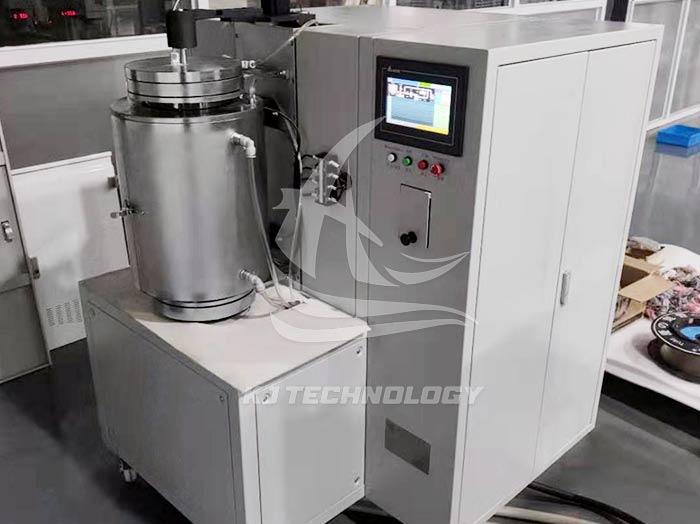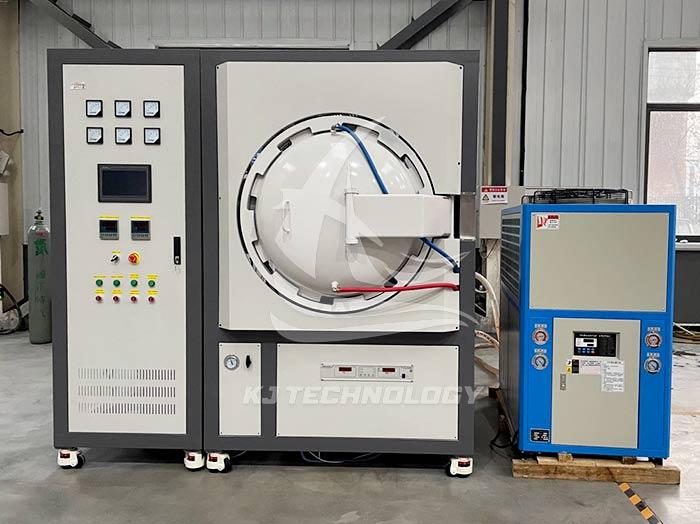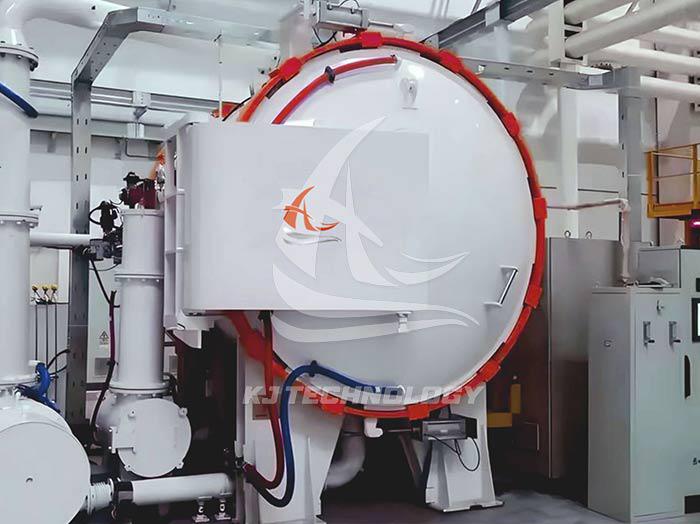Can industrial large vacuum furnaces be gas filled?
 11-14-2025 Author: KJ technology
11-14-2025 Author: KJ technology
Industrial large-scale vacuum electric furnaces can be ventilated, and the ventilation function is one of the core means to achieve diversified heat treatment processes. By injecting different types of gases (such as inert gas, active gas, or mixed gas) into the vacuum furnace, the atmosphere inside the furnace can be precisely controlled to meet the requirements of anti-oxidation, carburizing, nitriding, degassing, etc. during material processing. The following analysis will focus on technical principles, ventilation methods, gas types, and typical application scenarios:
1. Technical principle: The synergistic effect of vacuum environment and gas control
The ventilation function of industrial large-scale vacuum electric furnaces is based on the following principles:
Establishment of vacuum environment:
By using vacuum systems such as mechanical pumps and molecular pumps, the pressure inside the furnace is pumped to the target vacuum degree (usually 10 ⁻ ² to 10 ⁻⁴ Pa), isolating impurities such as oxygen and water vapor, and providing a clean foundation for subsequent processes.
Gas injection and control:
Gas type selection: Fill inert gases (such as nitrogen, argon), active gases (such as methane, ammonia), or mixed gases according to process requirements.
Pressure regulation: The gas flow rate and furnace pressure are precisely controlled through equipment such as mass flow meters and pressure sensors. The pressure range can be flexibly adjusted from low pressure (such as 100Pa) to high pressure (such as 10bar).
Atmosphere circulation: Some furnace types are equipped with gas circulation systems, which evenly distribute gas through fans or stirring devices to ensure consistent treatment effects in various parts of the workpiece.
Process implementation:
Gas plays different roles in heating, insulation, cooling, and other stages. For example, in the carburizing process, a mixture of methane and nitrogen gas is introduced to achieve diffusion of carbon atoms onto the surface of the workpiece through high-temperature decomposition; In the vacuum degassing process, filling argon gas can accelerate the discharge of internal pores in the workpiece.
2. Ventilation method: precise control in stages
The ventilation function of industrial large-scale vacuum furnaces is usually controlled in stages according to the process stage to achieve the best processing effect:
Heating stage:
Inert gas protection: Fill with nitrogen or argon gas to maintain a low pressure environment (such as 100-1000Pa) inside the furnace to prevent oxidation of the workpiece. For example, when heating titanium alloys, it is necessary to strictly isolate oxygen to avoid the formation of brittle oxide layers on the surface.
Active gas infiltration: In processes such as carburizing and nitriding, methane, ammonia, etc. are introduced to achieve element infiltration through high-temperature decomposition. For example, when carburizing gear steel, methane decomposes into carbon atoms at 900-950 ℃ and diffuses towards the surface of the workpiece to form a high carbon layer.
Insulation stage:
Stable atmosphere: Maintain a constant gas flow rate and pressure to ensure the continuous infiltration or degassing process of elements. For example, in the vacuum carburizing process, it is necessary to maintain a stable ratio of methane to nitrogen during the insulation stage to control the carbon potential.
Local atmosphere adjustment: By using partitioned ventilation or nozzle design, differentiated treatment of different parts of the workpiece can be achieved. For example, when nitriding long axis components, nitrogen atom distribution can be optimized through axial gas injection.
Cooling stage:
High pressure gas quenching: Fill with high-pressure nitrogen or helium gas (up to 10 bar), achieve rapid cooling through high-speed airflow, and form martensitic structure. For example, after vacuum high-pressure gas quenching, the hardness of mold steel can reach 58-62HRC, and the deformation is extremely small.
Graded cooling: First, introduce low-pressure gas to slowly cool down, then gradually increase pressure to accelerate cooling and reduce thermal stress. For example, when processing thin-walled parts, the "low pressure start+high pressure maintenance" strategy can reduce deformation by more than 50% compared to direct high pressure quenching.
3. Gas type: flexible selection according to process requirements
There are various types of gases that can be introduced into large industrial vacuum furnaces, including:
Inert gas:
Nitrogen (N ₂): Low cost, commonly used for general oxidation protection. For example, during vacuum annealing of stainless steel, nitrogen gas is filled to prevent surface oxidation and decarburization.
Argon (Ar): chemically more stable, suitable for high temperature or active metal processing. For example, when heating titanium alloy, argon gas is filled to prevent the surface from reacting with oxygen.
Helium (He): With high thermal conductivity, it is commonly used in high-pressure gas quenching processes and has a faster cooling rate than nitrogen.
Active gas
Methane (CH ₄): Used in carburizing processes to provide carbon atoms after decomposition. For example, when carburizing gear steel, a mixture of methane and nitrogen gas can control the carbon potential.
Ammonia gas (NH3): used in nitriding process to provide nitrogen atoms after decomposition. For example, when nitriding mold steel, ammonia gas decomposes at 500-550 ℃ to form a harder nitriding layer.
Acetylene (C ₂ H ₂): used in the carbon nitrogen co diffusion process, providing both carbon and nitrogen atoms.
Mixed gas:
Nitrogen+methane: used for low-pressure carburizing, controlling carbon potential by adjusting the ratio.
Nitrogen+hydrogen: used for reducing atmosphere treatment, such as bright annealing of stainless steel.
Argon+helium: used for ultra-high pressure gas quenching to achieve extremely fast cooling speed.
4. Typical application scenarios: covering the entire field of high-end manufacturing
Aerospace:
Titanium alloy treatment: argon gas is filled for oxidation prevention during heating, and high-pressure helium gas is used for quenching during cooling to achieve a balance between high strength and high toughness. For example, the landing gear of a certain model of aircraft has higher tensile strength after vacuum ventilation treatment.
Aluminum infiltration of high-temperature alloys: A mixture of aluminum vapor and argon gas is introduced to form an aluminum oxide coating at high temperatures, which enhances the oxidation resistance.
Automotive industry:
Gear carburizing: Introducing a mixture of methane and nitrogen gas to achieve an optimized combination of high carbon layer on the gear surface (hardness 60-62HRC) and core toughness (tensile strength ≥ 1000MPa).
Exhaust valve nitriding: Ammonia gas is introduced to form a 0.1-0.3mm thick nitriding layer on the valve seat surface, improving wear resistance and corrosion resistance.
Mold manufacturing:
Bright annealing of plastic molds: a mixture of nitrogen and hydrogen gas is introduced to eliminate processing stress, resulting in a surface smoothness of Ra0.2 or below.
Nitriding of die-casting molds: Ammonia gas is introduced to form a nitriding layer with a hardness of over 1000HV, which increases the lifespan of the mold.
Energy sector:
Nuclear fuel cladding treatment: argon gas is introduced to prevent oxidation and ensure material purity meets the strict requirements of nuclear power plants.
Preparation of Coating for Gas Turbine Blades: Aluminum vapor and argon gas are introduced to form a thermal barrier coating, which enhances the high-temperature resistance of the blades.








